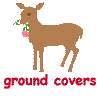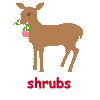


Deer in different areas have different tastes and will on occasion eat anything, particularly if the plants are fresh from the nursery and succulent. It is a wise precaution to cover with wire or use spray repellants on newly purchased plants. Because deer do seem to vary in what they will eat, the lists I have compiled are not absolute. The information is based on my experiences working in many sites in western Sonoma Country (Northwestern California). These lists are a good place to start from if you live in the general Santa Rosa or similar area. There are areas, such as the coast, or in the foothills, where almost nothing is left uneaten. When I am designing in a new area I use what is growing on the neighbor's property as indication of what might be sucessful. Anything that has silver, felted, or aromatic foliage is worth trying. Very low plants often escape the deer's attention and trees and vines only need to be protected until they are above the reach of the deer.
As the season progresses and there is less browse available, deer will eat plants they normally eschew. There is some thought that at the end of the dry summer it is the lack of water that drives the deer to eat our irrigated plants for the moisture they provide. Some folks think putting water out for the deer helps at that time.
Young deer don't always seem to know which plants they shouldn't eat and will try "non-edible" plants. Hopefully they grow up and don't keep at it. Using repellants or protecting favorite "borderline" plants when the adolescents are about might help.
Physical damage by the deer can be a problem. They walk over and crush plants, or break stems. Also the rubbing on branches by bucks when their horns are new and fuzzy can be impressively destructive. If this is a problem year after year and there is enough room, an out of the way corner of the garden can be planted with a few of the plants they seem to favor for rubbing their horns. I wouldn't use these plants anywhere else in the garden.
Repellants can provide some temporary protection. There are commercial sprays made of lion urine, rotten eggs, etc. that seem to work. I often use a tsp of chili pepper sauce in a gallon of water sprinkled or sprayed on the foliage of newly planted nursery plants. Sprays need to be renewed every few days or after heavy dew or rain. Radios, noisemakers and bars of soap haven't impressed me by their results, but lights attached to motion detectors have worked well for some people. When the garden will be unoccupied for a period of time, as during a vacation, there are some very pungent granular deer repellants that can be sprinkled broadscale to good effect. Just don't plan on gardening for a few days if you come home early.
Natives seem like they should be good in a deer tolerant landscape but actually there are very few that deer don't eat. I think there aren't supposed to be as concentrated populations of deer as we have nowadays. In the past, in the wild, the deer probably moved through areas just browsing lightly before moving on, giving the plants time to grow back







Copyright 2000 by Heidi Freestone All Rights Reserved To reproduce for other than personal use please ask for permission. Contact Myoan Press at gogarden@sonic.net